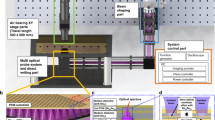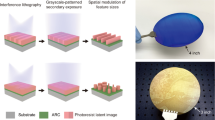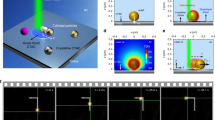Abstract
A number of non-lithographic techniques are now available for processing materials on the nanoscale, including optical techniques1,2,3,4,5,6,7 capable of producing features that are much smaller than the wavelength of light used. However, these techniques can be limited in speed, ease of use, cost of implementation, or the range of patterns they can write. Here we report how Bessel beam laser trapping of microspheres near surfaces can be used to enable near-field direct-write8,9 subwavelength nanopatterning. Using the microsphere as an objective lens to focus the processing laser, we demonstrate arbitrary patterns and individual features with minimum sizes of ∼100 nm (which is less than one-third the processing wavelength) and a positioning accuracy better than 40 nm in aqueous and chemical environments. Submicron spacing is maintained between the near-field objective and the substrate without active feedback control. If implemented with an array of optical traps, this approach could lead to a high-throughput probe-based method for patterning surfaces with subwavelength features.
This is a preview of subscription content, access via your institution
Access options
Subscribe to this journal
Receive 12 print issues and online access
$259.00 per year
only $21.58 per issue
Buy this article
- Purchase on Springer Link
- Instant access to full article PDF
Prices may be subject to local taxes which are calculated during checkout




Similar content being viewed by others
References
Kawata, S., Sun, H.-B., Tanaka, T. & Takada, K. Finer features for functional microdevices. Nature 412, 697–698 (2001).
Aeschlimann, M. et al. Adaptive subwavelength control of nano-optical fields. Nature 446, 301–304 (2007).
Chimmalgi, A., Grigoropoulos, C. P. & Komvopoulos, K. Surface nanostructuring by nano-femtosectond laser-assisted scanning force microscopy. J. Appl. Phys. 97, 104319 (2005).
Ohtsu, M., Kobayashi, K., Ito, H. & Lee, G.-H. Nanofabrication and atom manipulation by optical near-field and relevant quantum optical theory. Proc. IEEE 88, 1499–1519 (2000).
Hwang, D. J., Chimmalgi, A. & Grigoropoulos, C. P. Ablation of thin metal films by short-pulsed lasers coupled through near-field scanning optical microscopy probes. J. Appl. Phys. 99, 044905 (2006).
Betzig, E. & Trautman, J. K. Near-field optics: microscopy, spectroscopy, and surface modification beyond the diffraction limit. Science 257, 189–195 (1992).
Piglmayer, K., Denk, R. & Bauerle, D. Laser-induced surface patterning by means of microspheres. Appl. Phys. Lett. 80, 4693–4695 (2002).
Chrisey, D. B. Materials processing: the power of direct writing. Science 289, 879–881 (2000).
Arnold, C. B., Serra, P. & Pique, A. Laser direct write of complex materials. MRS Bull. 32, 23–31 (2007).
Munzer, H. J. et al. Local field enhancement effects for nanostructuring of surfaces. J. Microsc. 202, 129–135 (2001).
McGloin, D. & Dholakia, K. Bessel beams: diffraction in a new light. Contemp. Phys. 46, 15–28 (2005).
Garces-Chavez, V., McGloin, D., Melville, H., Sibbett, W. & Dholakia, K. Simultaneous micromanipulation in multiple planes using a self-reconstructing light beam. Nature 419, 145–147 (2002).
Israelachvili, J. N. Intermolecular and Surface Forces (Academic Press, Harcourt Brace Jovanovich, London, 1985).
Walz, J. Y. & Prieve, D. C. Prediction and measurement of the optical trapping forces on a microscopic dielectric sphere. Langmuir 8, 3073–3082 (1992).
Himmelbauer, M., Arenholz, E., Bauerle, D. & Schilcher, K. UV-laser-induced surface topology changes in polyimide. Appl. Phys. A 63, 337–339 (1996).
Piglmayer, K., Arenholz, E., Ortwein, C., Arnold, N. & Bauerle, D. Single-pulse ultraviolet laser-induced surface modification and ablation of polyimide. Appl. Phys. Lett. 73, 847–849 (1998).
Bauerle, D. Laser Processing and Chemistry (Springer, Berlin, 2000).
Malyshev, A. Y. & Bityurin, N. M. Laser swelling model for polymers irradiated by nanosecond pulses. Quant. Electron. 35, 825–830 (2005).
Lu, Q.-H., Li, M., Yin, J., Zhu, Z.-K. & Wang, Z.-G. Polyimide surface modification by pulsed ultraviolet laser irradiation with low fluence. J. Appl. Polym. Sci. 82, 2739–2743 (2001).
Minsky, M. S., White, M. & Hu, E. L. Room-temperature photoenhanced wet etching of GaN. Appl. Phys. Lett. 68, 1531–1533 (1996).
Cole, H. S., Liu, Y. Y., Rose, J. W. & Guida, R. Laser-induced selective copper deposition on polyimide. Appl. Phys. Lett. 53, 2111–2113 (1988).
Chen, D., Lu, Q. & Zhao, Y. Laser-induced site-selective silver seeding on polyimide for electroless copper plating. Appl. Surf. Sci. 253, 1573–1580 (2006).
Grier, D. G. A revolution in optical manipulation. Nature 424, 810–816 (2003).
Davis, J. A., Guertin, J. & Cottrell, D. M. Diffraction-free beams generated with programmable spatial light modulators. Appl. Opt. 32, 6368–6370 (1993).
McLeod, E., Hopkins, A. B. & Arnold, C. B. Multiscale Bessel beams generated by a tunable acoustic gradient index of refraction lens. Opt. Lett. 31, 3155–3157 (2006).
Tsai, T., McLeod, E. & Arnold, C. B. Generating Bessel beams with a tunable acoustic gradient index of refraction lens. Proc. SPIE 6326, 63261F (2006).
Yee, K. S. Numerical solution of initial boundary value problems involving Maxwell's equations in isotropic media. IEEE Trans. Antenn. Propag. AP-14, 302–307 (1966).
Mur, G. Absorbing boundary conditions for the finite-difference approximation of the time-domain electromagnetic-field equations. IEEE Trans. Electromagn. C EMC-23, 377–382 (1981).
Acknowledgements
We thank J. Fleischer and M. Haataja for providing helpful insight and critiques, and N. Kattamis for providing helpful information regarding polyimide coating and thin film properties. Funding for this work was provided by Princeton University and Air Force Office of Scientific Research (AFOSR) (FA9550-08-1-0094).
Author information
Authors and Affiliations
Contributions
E.M. performed the experiments. E.M. and C.B.A. conceived and designed the experiments, analysed the data, and co-wrote the paper.
Corresponding author
Supplementary information
Rights and permissions
About this article
Cite this article
Mcleod, E., Arnold, C. Subwavelength direct-write nanopatterning using optically trapped microspheres. Nature Nanotech 3, 413–417 (2008). https://doi.org/10.1038/nnano.2008.150
Received:
Accepted:
Published:
Issue Date:
DOI: https://doi.org/10.1038/nnano.2008.150
This article is cited by
-
Self-organized patterning on azo molecular glass film via optical near-field effect
Communications Materials (2023)
-
Engineering an ultra-narrow localized optical beam with a hybrid flat-ended microcylinder
Optical and Quantum Electronics (2021)
-
O-FIB: far-field-induced near-field breakdown for direct nanowriting in an atmospheric environment
Light: Science & Applications (2020)
-
Effects of light polarization in photonic nanojet
Optical and Quantum Electronics (2019)



